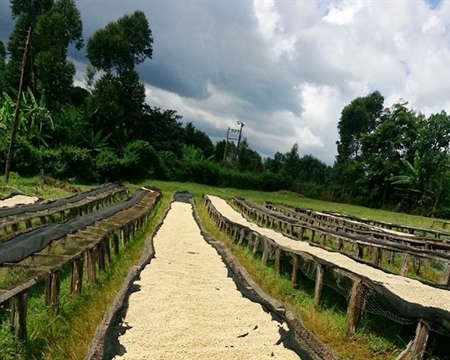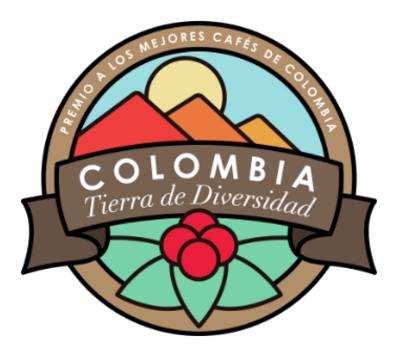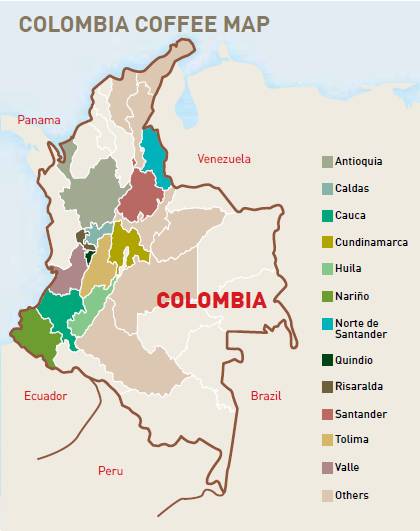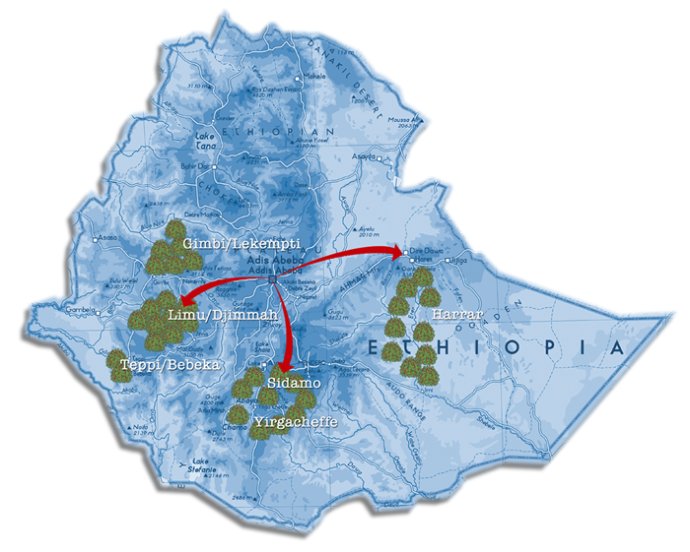General situation of Variety planting region, Harvest season and Geography in Coffee Bean producing area of Colombia
For professional baristas, please follow the coffee workshop (Wechat official account cafe_style)
About coffee cultivation in Colombia
Planting area and harvest season
Columbus coffee cultivation is distributed along the Andes Mountains, from south to north, roughly divided into northern producing areas (green), central producing areas (orange, purple) and southern producing areas (yellow), in which orange-purple areas have primary and secondary production seasons. green and yellow areas have one season.
Harvest season [by region]
Due to the differences in geographical and climatic characteristics from north to south, the north-south production season is just opposite, while the central part has its own primary and secondary production seasons according to whether it is south or north. It can be said that beans are produced all the year round. We mainly distinguish regions according to winter production season and summer production season.
The winter season is from September to December, including the following areas
Magdalena Magdalena common items
Santander Santander
Antioquia Andi O'Quia common items
North of Santander North of Santander
Boyaca Boyaca
Meta Matta
The central region near the north will have two primary and secondary seasons, the main season is from September to December in winter, and the secondary season is between April and May in summer.
Caldas Caldas
Risaralada Salala da
Parts of Cundinamarca Quintina Maka have begun to emerge in the market.
Some areas of Quinido Jindio began to emerge in the market.
Common items of sub-ashes in some areas of Tolima Tolima
The central region near the south will have two primary and secondary seasons, the main season is from March to June in summer, and the secondary season is from October to November in winter.
Parts of Valle Waye began to emerge in the market.
Parts of Quindio Kingdeo
Cundinamarca Quintina Maka part of the area
Part of Tolima Tolima
The summer production season is from March to June, including the following areas
Part of Valle Waye
The bone ash grade of Cauca test is common.
Cundinamarca Quintina Maka part of the area
Huila Huilan ashes are common
Narino Na Linglong secondary bone ash grade is common
Note: the production season here refers to the stage of post-processing when the coffee fruit is ripe and harvested in the producing area. Usually 2-3 months after this stage, the beans of the real new production season will arrive at our consumption end.

Planting pattern: 95% of the growers are small farmers, and the family planting area is less than 5 hectares.
Production: the average annual output of small farmers' families is 25 bags, each bag 70kg specification
Planting altitude: 1000-2500 m
Annual precipitation: 1000-2500 mm
Average annual temperature: 15.8-20.5 degrees Celsius
Planting varieties: in addition to Kaddura Caturra, Bourbon Bourbon, Tippika Typica and Parkmara, which are common in America, Colombia also has three disease-resistant varieties peculiar to Colombia, namely Castillo Castillo and Tabi Tabi Colombian Colombia with the same name as the country. Of course, there are also some rare and valuable varieties such as Rosa Gesha, small-grained Mocha Mocca, Rume Sudan Romer Sultan, Eugenioides Eugene Odes, Laurina pointed Bourbon, Maraguesa Mara Rosa (a natural hybrid between Malaggippe and Rosa).
Shade trees: the shade trees seen in the producing areas are lemon trees and orange trees. the lemons in their lemon trees are very similar to oranges, but they taste very sour, and there is a local way to eat them with a strong liquor, just like drinking cocktails. It tastes good.
Production season: affected by the topography of the Andes, Colombia is divided into three regions from south to north, northern, central, and southern; the northern part of the south has a distinct production season, and the central part has two primary and secondary seasons according to the north or the south, respectively. there's information behind it.
Treatment methods: water washing is the main way, and now there are sun and honey treatment methods; in water washing methods, most of the conventional fermentation processes are anhydrous fermentation Dry Fermentation, open environment; now there are some processes that introduce red wine treatment into coffee treatment to do anaerobic and oxygen-controlled fermentation treatment.
Drying: after drying, there are greenhouse Green House (not as big as the vegetable growing greenhouse in our countryside, think about the size of the balcony sunshine room), drying field Patio (an open space on the cement floor, recently seen wooden floor), dryer (many small farmers have this at home)
Industry chain: Columbia Coffee producers Association FNC, Colombia National Coffee Research Center CENICAFE, regional coffee production associations (Colombia has 32 regional Departments, of which 20 are coffee growers), traders, international roasters, and you, "God" who read the words.
The biggest purpose of FNC is to be the spokesman of Colombian Coffee, promising that FNC is willing to buy as long as coffee farmers are willing to sell coffee. FNC not only works as the international ambassador of Colombian Coffee to do coffee marketing in the international market, and successfully creates the image of "Uncle Juan"; at the same time, Colombia has also invested a lot of manpower and material resources to participate in farmers' planting and production, management and continuous operation.
CENICAFE was founded in 1938, as the technical support of FNC, committed to coffee variety breeding, farmers planting production agronomic training.

About the variety
The early varieties planted in Colombia were the old iron pickup and bourbon, which were replaced by Kaddura in 1970; Kaddura is not only more productive per plant than iron pickup and bourbon, but also can be planted more per unit of acreage because the tree is more compact.
Since 1961, CENICAFE began to study Timor varieties of Robusta blood, and then selected Timor and Caturra into Columbia's Katim Catimor series. After five generations of breeding, CENICAFE released Colombia's first disease-resistant variety Colombia in 1982, and then after the emergence of leaf rust in 1983, Colombia varieties began to be planted in large quantities.
Subsequently, CENICAFE continued its research and development, releasing the second disease-resistant variety Tabi (a hybrid of iron pickup, bourbon and Timor) in 2002, and the most functional disease-resistant variety Castillo so far in 2005. After the outbreak of leaf rust in 2008, Colombia began to vigorously promote Castillo cultivation.
Implementation and support of Castillo varieties
This is a coffee reform support loan program launched in Colombia in 2012 for small farmers to grow a disease-resistant variety Castillo.
A seven-year loan scheme
At the time of final repayment, farmers only need to return 60% of the principal, and the other 40% will be borne by the government (some banks are willing to pay the bill)
You don't have to make any repayment in the first two years of the loan.
The annual interest rate is 11% at the beginning of the third year, and the farmers will repay the loan every year after the funds are collected at the end of the production season.
Of course, whether farmers transplant Castillo is completely voluntary, the above plan is only for Castillo planting trial.
The latest news is that CENICAFE released a new disease-resistant variety CENICAFE 1 in December 2016, which is also a hybrid of Kaddura and Timor (1343). It has the same good flavor as Castillo, has a higher yield and is resistant to leaf rust and coffee beetles.

About how to deal with it
Colombian coffee is mostly washed, and every small farmer family has a small special processor (Ecomill or Eco-Pulper). The harvested coffee fruit is poured into it, which removes not only the peel and pulp, but also most of the pectin, and only a very small amount of water is needed. Next, the shell beans with a small amount of pectin will go into a small pool or container, which may be a cement pool (some tiles) or a stainless steel bucket that will ferment overnight and loosen the residual pectin. Rinse with clean water the next day, and the washing process is completed.
Dry, according to the weather, if the weather is good, of course the first choice is natural drying, there will be a small shed laid on the wooden scaffolding to dry in the shade; otherwise, it will be laid on an empty cement floor for drying; if the weather is not good, if it rains continuously, then use a dryer to dry, the dryer will have an intake temperature control, usually about 50 degrees Celsius.
About the associations and organizations of various places (DEPARTMENT)
Colombia's administrative plan is to divide the country into 32 regions (DEPARTMENT). Like our province, each region has its own capital and its own regional grower association organization for growers. 20 of those 32 regions are coffee growers. A regional association has been set up in the capital of these regions to carry out planting projects in collaboration with farmers' producers in the region. At the same time, speaking on behalf of the producers on a higher scale, some of them are listed below.
Antioquia
Caldas
Cauca
Cundinamarca
Huila
Magdalena
Norte de Santander
Quind í o
Risaralda
Santander
Tolima
Valle

About the coffee competition
There are two forms of international coffee competition in Colombia from 2005 to now.
2005-2015 Magazine Coe
Since 2016, Colombia has organized its first international coffee competition, named LAND OF DIVERSITY, and conducted its first offline auction. The new competition also has a great change compared with the competition system of CoE.
It is divided into two categories: small batches (SMALL BATCH) and large batches (LARGE BATCH). For the first time, large batches (LARGE BATCH) are included in the bidding system; small batches start at US $5 / lb and large quantities start at US $2 / lb.
The classification of coffee is evaluated by attributes, and the five attribute categories of small batches of coffee are evaluated in the tournament. Each coffee can be nominated in one or more categories and win the final championship award in this category. The five attribute categories are: sour Acidity, taste Body, balance Balance, softness Mildness (official website is also called softness, when I was there, I remember the translation said clean-cup cleanliness, here we are based on the official website), the idiosyncrasy deals with flavor Exoticness.
For large batches, regardless of the attributes, it only depends on whether the overall flavor is different from the cleanliness and fineness of bulk products.
Our two beans are a small batch (EL PLAN) and a large batch (EL RANCHO). You can compare them.
Important Notice :
前街咖啡 FrontStreet Coffee has moved to new addredd:
FrontStreet Coffee Address: 315,Donghua East Road,GuangZhou
Tel:020 38364473
- Prev

About the Colombian FNC National Federation of Coffee Growers of Colombia
Professional barista exchanges please follow the coffee workshop (Wechat official account cafe_style) about the greatest purpose of Colombian FNC FNC is to be the spokesman of Colombian coffee, promising that as long as coffee farmers are willing to sell coffee, FNC is willing to buy, FNC not only do Colombian coffee international ambassador to do coffee marketing in the international market, successfully created Uncle Juan
- Next

Harar Hara, an Ethiopian Ethiopia boutique coffee producing area, is an eastern Ethiopian producing area.
Professional baristas please follow the coffee workshop (Wechat official account cafe_style) Harar is a famous producing area in eastern Ethiopia, ET sun-cured coffee representative, but also a boutique coffee world sun treatment, or natural treatment classic. Harar, with a history of more than 1300 years, Harar is a veritable ancient city. Although archaeologists believe that the city was built in the 10th century
Related
- Detailed explanation of Jadeite planting Land in Panamanian Jadeite Manor introduction to the grading system of Jadeite competitive bidding, Red bid, Green bid and Rose Summer
- Story of Coffee planting in Brenka region of Costa Rica Stonehenge Manor anaerobic heavy honey treatment of flavor mouth
- What's on the barrel of Blue Mountain Coffee beans?
- Can American coffee also pull flowers? How to use hot American style to pull out a good-looking pattern?
- Can you make a cold extract with coffee beans? What is the right proportion for cold-extracted coffee formula?
- Indonesian PWN Gold Mandrine Coffee Origin Features Flavor How to Chong? Mandolin coffee is American.
- A brief introduction to the flavor characteristics of Brazilian yellow bourbon coffee beans
- What is the effect of different water quality on the flavor of cold-extracted coffee? What kind of water is best for brewing coffee?
- Why do you think of Rose Summer whenever you mention Panamanian coffee?
- Introduction to the characteristics of authentic blue mountain coffee bean producing areas? What is the CIB Coffee Authority in Jamaica?

